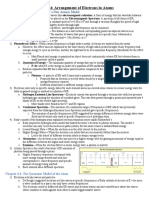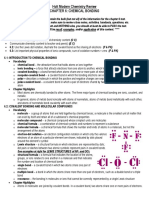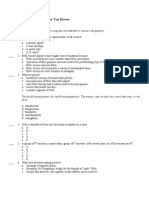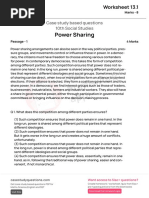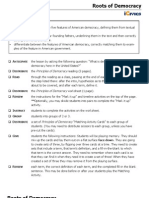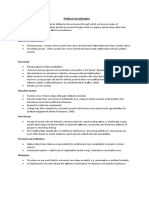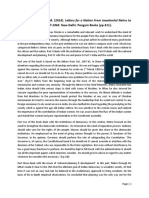0 ratings0% found this document useful (0 votes)
100 viewsHistory 23.2
History 23.2
Uploaded by
ayeshaThe revolutions of 1830 and 1848 saw the rise of liberalism and nationalism across Europe as people sought greater political rights and independence for their nations. The 1830 revolution in France established a constitutional monarchy, while revolutions in Belgium, Poland, and Italy aimed to gain independence from foreign rulers. The 1848 revolutions were sparked by unrest in France and spread to Germany and the Austrian Empire, as national assemblies were formed but ultimately failed to unite the regions. Revolts also occurred in the Italian states seeking independence from Austrian control, but the old order was restored across Europe as divisions among nationalities undermined the revolutionary movements.
Copyright:
© All Rights Reserved
Available Formats
Download as PDF, TXT or read online from Scribd
History 23.2
History 23.2
Uploaded by
ayesha0 ratings0% found this document useful (0 votes)
100 views2 pagesThe revolutions of 1830 and 1848 saw the rise of liberalism and nationalism across Europe as people sought greater political rights and independence for their nations. The 1830 revolution in France established a constitutional monarchy, while revolutions in Belgium, Poland, and Italy aimed to gain independence from foreign rulers. The 1848 revolutions were sparked by unrest in France and spread to Germany and the Austrian Empire, as national assemblies were formed but ultimately failed to unite the regions. Revolts also occurred in the Italian states seeking independence from Austrian control, but the old order was restored across Europe as divisions among nationalities undermined the revolutionary movements.
Original Description:
McGraw Hill World History & Geography Chapter 23 lesson 2 notes :)
Copyright
© © All Rights Reserved
Available Formats
PDF, TXT or read online from Scribd
Share this document
Did you find this document useful?
Is this content inappropriate?
The revolutions of 1830 and 1848 saw the rise of liberalism and nationalism across Europe as people sought greater political rights and independence for their nations. The 1830 revolution in France established a constitutional monarchy, while revolutions in Belgium, Poland, and Italy aimed to gain independence from foreign rulers. The 1848 revolutions were sparked by unrest in France and spread to Germany and the Austrian Empire, as national assemblies were formed but ultimately failed to unite the regions. Revolts also occurred in the Italian states seeking independence from Austrian control, but the old order was restored across Europe as divisions among nationalities undermined the revolutionary movements.
Copyright:
© All Rights Reserved
Available Formats
Download as PDF, TXT or read online from Scribd
Download as pdf or txt
0 ratings0% found this document useful (0 votes)
100 views2 pagesHistory 23.2
History 23.2
Uploaded by
ayeshaThe revolutions of 1830 and 1848 saw the rise of liberalism and nationalism across Europe as people sought greater political rights and independence for their nations. The 1830 revolution in France established a constitutional monarchy, while revolutions in Belgium, Poland, and Italy aimed to gain independence from foreign rulers. The 1848 revolutions were sparked by unrest in France and spread to Germany and the Austrian Empire, as national assemblies were formed but ultimately failed to unite the regions. Revolts also occurred in the Italian states seeking independence from Austrian control, but the old order was restored across Europe as divisions among nationalities undermined the revolutionary movements.
Copyright:
© All Rights Reserved
Available Formats
Download as PDF, TXT or read online from Scribd
Download as pdf or txt
You are on page 1of 2
23.
2 Nationalism and Political Revolutions
THE REVOLUTIONS OF THE 1830s
- Liberalism and Nationalism began to break through the conservative domination of Europe
- In France, the Bourbon monarch Charles X, a reactionary, attempted to censor the press and
take away voting rights from the middle class
- Liberals overthrew Charles X, and established a constitutional monarchy
- Louis-Philippe, cousin of Charles X, took the throne
- Political support came from the upper-middle class
- 1830: 3 more revolutions occurred in Europe; Nationalism: chief force in all three of them
- Belgium: annexed to the former Dutch Republic, rebelled and created an independent state
- Poland and Italy: ruled by foreign powers, and made efforts to break free; less successful
- Russia: troops crushed the Polish attempt to establish an independent nation
- Austria: troops marched south and put down revolts 8n several Italian states
THE REVOLUTIONS OF THE 1848
- Another French Revolution
- Revolution in France was the spark for revolution in other countries
- Severe economic problems began in 1846; b rought hardship in France to the lower
middle class, workers, and peasants
- Members of the middle class clamored for the right to vote; gov’t of Louis-Philippe
refused to make changes, opposition grew
- Monarchy overthrown: 1848
- A group of moderate and radical republicans set up a temporary gov’t; Republicans were
people who wanted France to be a republic— a gov’t in which leaders are elected
- Called for the election of representatives to a Constituent Assembly that would
draw up a new constitution
- Election would be determined by universal male suffrage, meaning all adult men
could vote
- They also set up national workshops to provide work for the unemployed
- March-June: the number of unemployed enrolled in the national workshops rose
from about 66,000 to 120,000; treasuries were emptied and moderates were
frightened (closed workshops on June 21, 1848)
- Workers revolted; gov’t crushed the working-class revolt; thousands were killed
and sent to the French prison colony of Algeria in Northern Africa
- The new French constitution, ratified on November 4, 1848, set up a republic called the
“Second Republic”
- Has a single legislature elected by universal male suffrage
- President: served for 4 years
- Revolt in the German States
- News of the 1848 revolution in France led to upheaval in other parts of Europe
- Austria and Prussia: two great powers
- Cries for change led many German rulers to promise constitutions, a free press, jury
trials, and other liberal reforms
- May 1848: all-German parliament, Frankfurt Assembly, was held to fulfill a liberal and
nationalist dream— the preparation of a constitution for a new united Germany
- Provided for a German state with a parliamentary gov’t and a hereditary emperor
ruling under a limited monarchy
- Also allowed the direct election of deputies to the parliament by universal male
suffrage
- Eventually failed to gain its support needed to achieve its goal
- German unification was NOT ACHIEVED
- Revolutions in Central Europe
- Austrian Empire: multinational empire (a collection of different peoples including
Germans, Czechs, Magyars (Hungarians), Slovaks, Romanians, Slovenes, Poles,
Croats, Serbs, Ruthenians (Ukrainians), and Italians
- Only the German-speaking Hapsburg dynasty held the empire together
- Germans played a leading role in governing the Austrian Empire
- March 1848: demonstrations erupted in major cities; to calm the demonstrators, the
Hapsburg court dismissed Metternich (Austrian foreign minister)
- Vienna: revolutionary forces took control of the capital and demanded a liberal
constitution
- Gov’t gave Hungary its own legislature
- Bohemia: Czechs clamored for their own gov’t
- Austrian officials had made concession to appease the revolutionaries but were
determined to reestablish their control over the empire
- June 1848: Austrian military forces crushed the Czech rebels in Prague
- Revolutions in the Austrian Empire had FAILED
- Revolts in the Italian States
- Congress of Vienna had set up nine states in Italy, which were divided among the
European powers
- Kingdom of Piedmont; Two Sicilies (Naples and Sicily); the Papal States; a
handful of small states; and the northern provinces of Lombardy and Venetia
- 1848: a revolt broke out against the Austrians in Lombardy and Venetia
- Revolutionaries in other Italian states created liberal constitutions and a unified Italy
- By 1849, the Austrians had reestablished complete control over Lombardy and Venetia
THE FAILURES OF 1848
- The unity of revolutionaries had made the revolutions possible
- Nationalities everywhere had also revolted in pursuit of self-government
- Little was achieved as divisions among nationalities proved disastrous
- Minorities fought each other; old order prevailed
- The forces of nationalism and liberalism continued to influence political events
You might also like
- Rate of Change and Slope AnswerDocument2 pagesRate of Change and Slope Answerayesha67% (3)
- Honors Geometry Homework Answers For Section 11.6Document10 pagesHonors Geometry Homework Answers For Section 11.6Danilo Fronda Jr.No ratings yet
- Linear Relations and Functions AnswersDocument2 pagesLinear Relations and Functions Answersayesha40% (10)
- Mid-Chapter Quiz AnswersDocument1 pageMid-Chapter Quiz Answersapi-2629542770% (1)
- Unit Test Reasoning & Proof: Common Core AlignedDocument13 pagesUnit Test Reasoning & Proof: Common Core AlignedMaria Manuela Chermont de Britto Santos PereiraNo ratings yet
- 2.4 Gunpowder EmpiresDocument2 pages2.4 Gunpowder EmpiresNikoli LemonsNo ratings yet
- 10 1 ProbabilityDocument2 pages10 1 Probabilityapi-25931785No ratings yet
- Chapter 1 Book AnswersDocument30 pagesChapter 1 Book Answersapi-247437524No ratings yet
- CH Standardized Test Review 1-6 KeyDocument3 pagesCH Standardized Test Review 1-6 KeyInmaculada RodriguezNo ratings yet
- 11-1 Ap AnswersDocument1 page11-1 Ap Answersapi-505532695No ratings yet
- AP Comp Gov: List of Key TermsDocument10 pagesAP Comp Gov: List of Key TermsGarfield TangNo ratings yet
- Cold War Chapter-1 MCQDocument2 pagesCold War Chapter-1 MCQNILESH KUMAR VISHKARMANo ratings yet
- Endocrine SystemDocument2 pagesEndocrine SystemEldie OcarizaNo ratings yet
- CH 14 Study GuidesDocument10 pagesCH 14 Study Guides4b00d1No ratings yet
- Quiz 1.4Document3 pagesQuiz 1.4hjNo ratings yet
- Chapter 3 Motion and Vectors Chapter Test B With AnswersDocument7 pagesChapter 3 Motion and Vectors Chapter Test B With AnswersLiliNo ratings yet
- Dimensional Analysis Practice ProblemsDocument4 pagesDimensional Analysis Practice ProblemsAngel SolivanNo ratings yet
- Whitman Poem Answer KeyDocument2 pagesWhitman Poem Answer Keyprecious agapitoNo ratings yet
- Gunpowder Empires DebateDocument1 pageGunpowder Empires Debateapi-388917218No ratings yet
- Cumulative Review Units 1-3Document11 pagesCumulative Review Units 1-3api-262033656No ratings yet
- CH 19 Test PDFDocument6 pagesCH 19 Test PDFgrassyfilth100% (1)
- Chapter 13 Test A RNA and Protein Synthesis ANSWERS PDFDocument6 pagesChapter 13 Test A RNA and Protein Synthesis ANSWERS PDFxspiiirONo ratings yet
- hssb1400t ChaptestbDocument5 pageshssb1400t ChaptestbMarwan MahmoudNo ratings yet
- 02 Atomic Structure Que. Final EDocument31 pages02 Atomic Structure Que. Final EDIPESHNo ratings yet
- Chapter 3 Motion and Vectors Section Quiz On Vectors With AnswersDocument3 pagesChapter 3 Motion and Vectors Section Quiz On Vectors With AnswersLili100% (1)
- Chapter 9Document12 pagesChapter 9Eubin ChoiNo ratings yet
- Chapter 13 Organisms and Population MCQDocument2 pagesChapter 13 Organisms and Population MCQChetan JavaliNo ratings yet
- A1 Ch19studyguideDocument3 pagesA1 Ch19studyguideJana Aldour100% (2)
- Chapter 21 QuizDocument4 pagesChapter 21 QuizMeronSolomonNo ratings yet
- ch 14 chapter test aDocument5 pagesch 14 chapter test ayarakhader301No ratings yet
- Q.2 Revision Worksheet-2Document12 pagesQ.2 Revision Worksheet-2Mohammad TakkoushNo ratings yet
- Force Test Key HonorsDocument5 pagesForce Test Key HonorsekoskeyNo ratings yet
- Chapter 4: Arrangement of Electrons in Atoms: Chapter 4.1: The Development of A New Atomic ModelDocument2 pagesChapter 4: Arrangement of Electrons in Atoms: Chapter 4.1: The Development of A New Atomic Modelrrr rrrNo ratings yet
- Cold War Test QuestionsDocument4 pagesCold War Test Questionsdanieljohnarboleda100% (2)
- Chapter 15 The Renaissance NotesDocument7 pagesChapter 15 The Renaissance NotesKyle KuriharaNo ratings yet
- Unit 2 Chemistry of Life Review PacketDocument7 pagesUnit 2 Chemistry of Life Review PacketShannon Erdman100% (1)
- Lit17 EV G11 U3 AWC ST DOUG TESTDocument10 pagesLit17 EV G11 U3 AWC ST DOUG TESTmashary aldawoodNo ratings yet
- Ls. 4 Altitudes and Medians Std.8Document5 pagesLs. 4 Altitudes and Medians Std.8Aakash SharmaNo ratings yet
- Science Notebook - Methods of ScienceDocument6 pagesScience Notebook - Methods of ScienceJean Carlos Tejada SantosNo ratings yet
- Unit 4 Focus SheetDocument1 pageUnit 4 Focus SheetOndra VlasanyNo ratings yet
- Average Velocity and DisplacementDocument2 pagesAverage Velocity and DisplacementTewodros Abate100% (1)
- Answers For 6.6: 6.6 Skill Practice 1. 12.) ) 13. 14. 15. 16. 17. 18. 19. A-B. S CDocument4 pagesAnswers For 6.6: 6.6 Skill Practice 1. 12.) ) 13. 14. 15. 16. 17. 18. 19. A-B. S CsisikaNo ratings yet
- Worksheet A Key Topic 2.1 Change in Arithmetic and Geometric SequencesDocument2 pagesWorksheet A Key Topic 2.1 Change in Arithmetic and Geometric Sequencesiamjoel0108No ratings yet
- Multiple Choice (2 Points Each) : Astronomy Unit TestDocument6 pagesMultiple Choice (2 Points Each) : Astronomy Unit TestSaida Mtz G100% (1)
- Chemistry Chapter 6 ReviewDocument3 pagesChemistry Chapter 6 Reviewjuan carlos quispe mamaniNo ratings yet
- Ms Excel: Computer MCQ'SDocument31 pagesMs Excel: Computer MCQ'SMonu BeniwalNo ratings yet
- Special Right TriangleDocument1 pageSpecial Right TriangleFitri DewiNo ratings yet
- HONORS Chapter 5 Test 2010 PDFDocument13 pagesHONORS Chapter 5 Test 2010 PDFAnonymous QfYZQy0% (1)
- Alg 2 First Semester Exam Review Ch. 1-6 MaxDocument189 pagesAlg 2 First Semester Exam Review Ch. 1-6 MaxDylan BeardNo ratings yet
- MAth Unit-Circles PracticeDocument112 pagesMAth Unit-Circles PracticeMirja DjokovicNo ratings yet
- Lesson 3: Rates of Change in Linear & Quadratic Functions: The Average Rate of Change and The Secant LineDocument6 pagesLesson 3: Rates of Change in Linear & Quadratic Functions: The Average Rate of Change and The Secant LineLauren DarbyNo ratings yet
- Computer PracticalDocument6 pagesComputer PracticalMuhammad Ashhad Raza100% (1)
- Unit TestDocument13 pagesUnit TestKring Kring K. Kringers100% (1)
- Chapter 5 Practice TestDocument14 pagesChapter 5 Practice TestHarvey VillarinNo ratings yet
- Examview - Chemistry Applications Yearly AssessmentDocument25 pagesExamview - Chemistry Applications Yearly Assessmentapi-232424041No ratings yet
- Bonding Questions 1Document5 pagesBonding Questions 1Tarek FaramawyNo ratings yet
- Exam I Questions 01Document31 pagesExam I Questions 01bravdaNo ratings yet
- Gilded Age TestDocument16 pagesGilded Age Testbenh10No ratings yet
- Chaptest BDocument6 pagesChaptest Bdeezm579No ratings yet
- Rise of Nationalism in EuropeDocument17 pagesRise of Nationalism in EuropeHarshit kumar SinhaNo ratings yet
- The Bourbon RestaurationDocument22 pagesThe Bourbon RestaurationelbarnaouidemnatiNo ratings yet
- PPT-Rise of Nationalism in Europe-XDocument90 pagesPPT-Rise of Nationalism in Europe-Xrajat kasniaNo ratings yet
- The Rise of Nationalism in Europe - 01Document52 pagesThe Rise of Nationalism in Europe - 01Megh PanchalNo ratings yet
- Solving Compound and Absolute Value InequalitiesDocument6 pagesSolving Compound and Absolute Value InequalitiesayeshaNo ratings yet
- Linear Relations and FunctionsDocument2 pagesLinear Relations and FunctionsayeshaNo ratings yet
- Relations and Functions AnswersDocument2 pagesRelations and Functions Answersayesha100% (1)
- Relations and FunctionsDocument2 pagesRelations and FunctionsayeshaNo ratings yet
- Rate of Change and SlopeDocument2 pagesRate of Change and SlopeayeshaNo ratings yet
- History 23.1 (The Industrial Revolution)Document3 pagesHistory 23.1 (The Industrial Revolution)ayeshaNo ratings yet
- Jimenez, Katrina - Global CitizenshipDocument3 pagesJimenez, Katrina - Global CitizenshipKatrina JimenezNo ratings yet
- PG Syllabus Kashmir UniversityDocument4 pagesPG Syllabus Kashmir Universityyawerahmad052No ratings yet
- (Worksheet 13.1) - (Power Sharing)Document5 pages(Worksheet 13.1) - (Power Sharing)DeepikaNo ratings yet
- Citizens and Subjects: Marco Polo's WorldDocument7 pagesCitizens and Subjects: Marco Polo's WorldGauravNo ratings yet
- SCRIPTDocument2 pagesSCRIPTMica MellizoNo ratings yet
- The World Between Wars 1900-1950 Part-IIDocument4 pagesThe World Between Wars 1900-1950 Part-IIAnonymous 9uu04elNo ratings yet
- Global SecurityDocument36 pagesGlobal SecurityAdrian CastroNo ratings yet
- PA104 FINALSlecture 1Document9 pagesPA104 FINALSlecture 1Jezreel SerranaNo ratings yet
- Class, Ethnicity and Democracy in Nigeria - The Failure of The First Republic (PDFDrive)Document389 pagesClass, Ethnicity and Democracy in Nigeria - The Failure of The First Republic (PDFDrive)Lonny EzenNo ratings yet
- And Not A Shot Is Fired, by Jan KozákDocument47 pagesAnd Not A Shot Is Fired, by Jan KozáktronedotnetNo ratings yet
- Roots of Democracy Complete-Lesson 2 AttchmntDocument10 pagesRoots of Democracy Complete-Lesson 2 AttchmntLa'Quisha JohnsonNo ratings yet
- Realismslides 160108162555 PDFDocument15 pagesRealismslides 160108162555 PDFJawad Ul Hassan ShahNo ratings yet
- Romania in 1920s - Stephen Fischer GalatiDocument4 pagesRomania in 1920s - Stephen Fischer GalatiGlyn EvansNo ratings yet
- Watts, Pro-Kurdish PartiesDocument27 pagesWatts, Pro-Kurdish PartiesAniko GáspárNo ratings yet
- Evropska Konvencije o Državljanstvu (1997)Document28 pagesEvropska Konvencije o Državljanstvu (1997)Danica Danka SekularacNo ratings yet
- Rosato, S. (2003) - The Flawed Logic of Democratic Peace TheoryDocument18 pagesRosato, S. (2003) - The Flawed Logic of Democratic Peace TheoryAgustin PaganiNo ratings yet
- Reaction PaperDocument4 pagesReaction PaperIain EvesNo ratings yet
- Economic SystemDocument7 pagesEconomic Systemrisma ramadhanNo ratings yet
- POL112 Exam PrepDocument22 pagesPOL112 Exam PrepCaitlin Campbell McNamaraNo ratings yet
- The French RevolutionDocument5 pagesThe French RevolutionAditya Ratn SinglaNo ratings yet
- Silent Features of SwitzerlandDocument1 pageSilent Features of Switzerlandoxford- iansNo ratings yet
- Period of Activism (1970-1972) 11 STEM CARSONDocument7 pagesPeriod of Activism (1970-1972) 11 STEM CARSONhercheys aberteNo ratings yet
- His Chief Ministers 1947-1963. New Delhi: Penguin Books (pp.311)Document2 pagesHis Chief Ministers 1947-1963. New Delhi: Penguin Books (pp.311)Tanu PatelNo ratings yet
- Richard Grove Excerpt From Green ImperialismDocument10 pagesRichard Grove Excerpt From Green ImperialismKimberly SantosNo ratings yet
- Causes of The French RevolutionDocument3 pagesCauses of The French RevolutionMohammed AsimNo ratings yet
- Irfan Habib Capital Accumulation Pre Colonial IndiaDocument25 pagesIrfan Habib Capital Accumulation Pre Colonial IndiaNajaf HaiderNo ratings yet
- DAHL - Pluralism RevisitedDocument14 pagesDAHL - Pluralism RevisitedMarina FrancoNo ratings yet
- Position Paper North KoreaDocument2 pagesPosition Paper North KoreaGabrielNo ratings yet
- DBQDocument1 pageDBQCannon CannonNo ratings yet
































